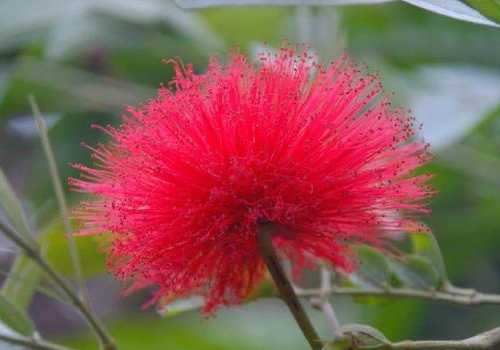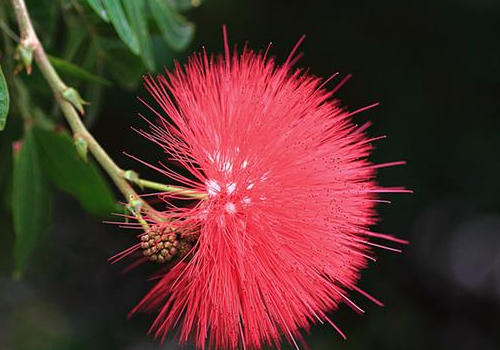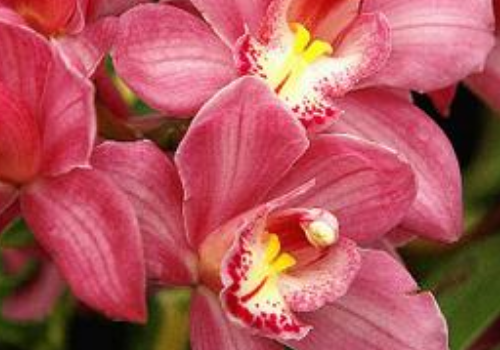Is Zhu tassel poisonous? what are the breeding methods?
Zhu tassel is not suitable to be placed indoors, and it grows best in places with plenty of light and has the highest ornamental value. Is the red tassel poisonous? What are the methods of reproduction:
Is Zhu tasseled poisonous?
Zhu tasseled flower is non-toxic, so we don't have to worry too much.
It is a deciduous shrub or small tree of the genus Leguminosae. It likes to grow in a warm and humid tropical climate. It is often cultivated as an ornamental flower and has very high ornamental value.

What are the propagation methods of Zhu tasseled flower:
1. Sowing and reproduction
The flowering period of Zhu tasseled flower is in August and September of each summer, and the best seed collection time is in October. Select full and complete healthy seeds and store them in a dry and ventilated environment. Wait until next spring to sow seeds.
Before sowing, the seeds need to be soaked in water with a water temperature of 60 degrees, change the water once a day for three consecutive days, and then take it out. Keep it moist and sprout. Sow the seeds in wet soil and they will germinate in about a week.
2. Cuttage propagation
In the cultivation of Zhu tasseled flowers, we usually choose the method of cutting propagation. Cut the healthy branches about 20 cm in length in spring, remove the dead leaves, and cut them in the wet sandy soil matrix. It is best to keep the temperature between 15 and 30 degrees, and pay attention to shading and moisturizing.
Zhu tasseled flower should also be protected from insect pests.
Breeding methods and matters needing attention of Rabbit Umbrella
Binomial Syneilesis aconitifolia
The plant kingdom.
Magnoliophyta, angiosperm phylum
Dicotyledonous class Magnoliopsida
Asterales of Chrysanthemum
Compositae Asteraceae
Belongs to Syneilesis.
Rabbit umbrella S. aconitifolia
Distributed in Northeast, North and East China
Rabbit umbrella alias: Qili Ma ("Nanjing folk herb"), an umbrella ("Guizhou folk medicine"), Nantian fan, umbrella handle grass ("Hunan Medicine"), bone umbrella ("Shaanxi Chinese herbal medicine"), broken parasol, iron cool umbrella, umbrella grass ("common folk herbs in Zhejiang"), umbrella vegetables, hat vegetables ("Handbook of commonly used Chinese Herbal Medicine in North China"), leading seven ("Shaanxi herbs"). It is the root or whole grass of Rabbit umbrella, a plant of Compositae. Take it in autumn, remove the soil and dry it in the sun. Main treatment: dispelling wind and dehumidification; detoxifying and activating blood circulation; detumescence and relieving pain. Main rheumatism numbness; limb pain; fall injury; irregular menstruation; dysmenorrhea; carbuncle swelling toxin; scrofula; hemorrhoids.
1. The original form of plant
Rabbit umbrella perennial herb, 70-120cm high. Rhizome creeping. Stem erect, simple, glabrous, slightly brownish. Root leaves 1, umbellate when young, pendulous. Cauline leaves alternate; petiole 2-16cm long; leaf blade round-peltate, palmately divided, straight to center, lobes pinnately divided, lobed to 4-9, margin irregularly sharp-toothed, glabrous, green above, gray-white below. Lower leaves 20-30cm in diameter, petioles 10-16 cm long, lobes 7-9. The upper leaves are smaller, 12-24cm in diameter, 2-6cm in length of petiole and 4-6 in lobes. Inflorescences capitate, crowded into compound corymbose, terminal, pedicel 5-16mm, with striate bracts at base; involucral bracts 1-layered, 5, glabrous, long elliptic, apex obtuse, margin membranous, 9-12 mm long; involucral bracts cylindric; flowers bisexual, 8-11, Corolla tubular ca. 1cm, apex 5-lobed, stamens 5, inserted on Corolla tube; ovary inferior, 1-loculed; style slender, stigma 2-lobed. Achenes, Terete, 5-6mm long, longitudinally striped; crown hairs grayish white or reddish brown. The flowering period is from July to September and the fruiting period is from September to October.
2. Growth habits:
Like warm, moist and sunny environment, resistant to semi-shade, cold and barren. The suitable temperature for growth is 15 ℃ ~ 22 ℃. It is better to choose loose and fertile loam instead of soil.
3. Basic information
Provenance: "Relief of famine Materia Medica".
Pinyin name: Tanner é rSignorn.
Habitat distribution: growing on hillside wasteland. Distributed in Northeast, North and East China and other places. Produced in Jiangsu, Guizhou, Hunan, Shaanxi, Hebei, Jilin and other places.
Character: dry root, nearly cylindrical, slender, mostly, irregularly curved, light brown surface, fine longitudinal wrinkles, yellow-white folded section, brown oil spots in the middle. It is better to be dry and without impurities.
Nature: bitter, warm, poisonous.
① "rescuing famine Materia Medica": bitter taste.
② "Guizhou Folk Medicine": mild temperature, pungent taste, non-toxic.
③ "Shaanxi Chinese Herbal Medicine": there is a small poison.
Usage: internal administration: fried soup, 10-25 grams; or soak in wine. External use: tamping.
Note:
① "Guizhou Folk Medicine": should not be taken by pregnant women.
② "Shaanxi Herbal Medicine": anti-ginger.
Excerpt: "* Dictionary" is the root or whole grass of Rabbit umbrella, a plant of Compositae. Take it in autumn, remove the soil and dry it in the sun. Main treatment: dispelling wind and dehumidification; detoxifying and activating blood circulation; detumescence and relieving pain. Main rheumatism numbness; limb pain; fall injury; irregular menstruation; dysmenorrhea; carbuncle swelling toxin; scrofula; hemorrhoids.
4. Introduction of families and genera
Compositae ompositae,Asteraceae
The largest family of the dicotyledonous subclass Chrysanthemum. There is a consistent floret structure. Florets tubular, actinomorphic, or ligulate and bilaterally symmetrical, or Corolla tubular and Corolla lobes 2-lipped. Most florets are densely arranged and covered with involucral bracts to form a consistent head. There are 13 families, 1300 genera and nearly 220000 species, which are distributed all over the world except Antarctica. There are about 3000 species belonging to 220 genera in China, among which 15 genera are endemic to China, including Chrysanthemum, Chrysanthemum morifolium, Chrysanthemum Taihang, Chrysanthemum morifolium, Chrysanthemum morifolium, Chrysanthemum, Bolocephalus, scape Chrysanthemum, Chrysanthemum morifolium, grasshopper leg Genus, Eriocheir sinensis, Eriocheir sinensis, Chrysanthemum, Purple Chrysanthemum and Junfan Chrysanthemum. The zebra chrysanthemum people are concentrated in northern and central South America, with great development in Africa. The Zelan people are concentrated in Central America. Aster is distributed all over the world. The Chunhuangju tribe is mainly a group of the Old Hemisphere, with few species in North America. The overlying flowers are mainly distributed in Africa and Oceania. The borage tribe is mainly distributed in Europe, and there is also great species diversity in North America. Among the 13 families of Compositae, sunflower is the largest, with 221 genera, mainly distributed in South and North America, while the smallest family is marigold, with only 11 genera, mainly distributed in South America. These two tribes are all introduced and cultivated or naturalized in China.
5. Chemical composition
The roots and leaves contain D-α-terpineol β-D-glucopyranoside-3-terpineol-4-diangelate (D-α-terpineol β-D-glucopyrano-3-D-glucopyranoside-3-methyl-4-yl diangelate). The above-mentioned compounds, linalool β-D murine O-glucoside-3-diangelate (linalool β-D murine) and glurmaceren D were found in the aboveground part.
6. Functional indications
Dispel wind and dehumidification, detoxify and activate blood circulation, reduce swelling and relieve pain. Treatment of rheumatism numbness, joint pain, carbuncle, swelling, fall injury. ① "Nanjing Folk Herb": root: decoction taken internally or externally applied to the affected area to treat injuries caused by falls.
② "Guizhou Folk Medicine": relaxing muscles and promoting blood circulation.
③ "Shaanxi Chinese Herbal Medicine"; dispelling wind and dampness, reducing swelling and pain. Treatment of rheumatic numbness, rheumatoid arthritis, waist and leg pain, fracture, irregular menstruation, dysmenorrhea.
④ "Zhejiang Folk Common Herbal Medicine": detumescence and detoxification. Treat neck lymphadenitis and snakebite.
7. Attached party
① treats rheumatism numbness, whole body bone pain: rabbit umbrella 20 grams, thorn five eggplant root 20 grams, white dragon beard 15 grams, small blood vine 15 grams, papaya root 15 grams. Soak wine 1000 milliliters. Take 50-75 grams twice a day. (Guizhou Folk Medicine)
② treatment of limb numbness, waist and leg pain: rabbit umbrella root 100g, soaked in 200ml of liquor, take it three times. (manual of commonly used Chinese Herbal Medicine in North China)
③ treatment of kidney deficiency lumbago: an umbrella root, soak wine clothes. (Guizhou Folk Medicine)
④ treatment of carbuncle gangrene: rabbit umbrella whole grass, pound, chicken egg whites. (Hunan Pharmaceutical Annals)
⑤ treatment of neck lymphadenitis: rabbit umbrella root 10g 20g. Pan-fried suit.
⑥ treatment of injury: rabbit umbrella whole grass or root smashed, add soju or 75% alcohol, external application.
⑦ treatment of snakebite: rabbit umbrella root smashed, add appropriate amount of yellow rice wine, external application of the wound. ("Zhejiang Folk Common Herbal Medicine" is listed below by ⑤.)
8. Identification of traditional Chinese medicine
Character identification
This product rhizome flat cylindrical, curved, length 1-4cm, diameter 0.3-0.8cm; surface brown, rough, with irregular links and longitudinal wrinkles, many roots downward on both sides. The root is cylindrical, curved, 5-15cm long, 0.1-0.3cm in diameter; the surface is grayish brown or light brown, densely covered with gray-white root hairs, with fine longitudinal wrinkles; brittle, easy to break, the fracture surface is slightly flat, the skin is white, the wood is brown. The air is slightly special and the taste is pungent and cool.
Microscopic identification
The root is crosscut to 200-500 μ m of root hair. The skin is broad, the cells are round, the wall is thickened, and there are several large secretions on the medial side of the cortex. The vascular bundle is tough outside and annular, with parenchyma cells inside. This product contains starch granules in thin layer cells and occasional small calcium oxalate needle crystals.
Powder characteristics
The outer non-glandular hairs of ① epidermis are unicellular, Zhu Duanjian.
② inulin crystals are numerous, fan-shaped or irregular.
The epidermal cells of ③ were oblong and thin.
④ fibers are long and narrow with oblique wall holes.
The ⑤ catheter is a catheter with striated holes.
⑥ wood parenchyma cells have striated pores.
The secretory tract of ⑦ is large and contains many inclusions.
9. Plant cultivation
1. Soil preparation and fertilization: it is appropriate to choose loose and fertile sandy soil or soil with high terrain and good drainage. Before sowing, apply 75000 kg of farm manure per hectare, turn it more than 30 cm deep, rake it flat and make a bed 100cm wide, ready to sow.
2. Propagation method: seed propagation, divided into autumn sowing and spring sowing. From seed harvest to ground freezing in early November, autumn sowing began to germinate at the beginning of April in the second year, and the whole seedling emerged from late April to early May. Spring sowing takes place from March to early April, and seedlings emerge from late April to early May. Spring sowing seeds must be treated at low temperature to allow the embryo to mature. If the seeds are sown more dry, they will not emerge in the same year. There are two sowing methods: strip method and sowing method. Seed treatment: from late October to early November, after mixing seeds with wet sand at 1:3, hide in the pit, dig a pit 45 cm deep and 30 cm long and 30 cm wide on the sunny slope, put a small amount of branches at the bottom of the pit, cover the seeds with a layer of leaves, and cover the seeds with 10 centimeters of soil. pay attention to rodent prevention during seed sand storage. Before and after the Qingming Festival the following year, most of the seeds have already sprouted before sowing. Strip sowing: open a shallow trench with a depth of 3 cm according to the row spacing of 15 cm, evenly sow the seeds, cover 3 cm of soil after sowing, and sow into the suppression. The use of 22.5-30kg per hectare. Sowing: spread the seeds evenly on the bank and cover the soil by 2cm. After sowing, make the seeds come into contact with the soil and press slightly. The sowing rate is 30 kg per hectare. The seeds were sown in spring after treatment, and the seedlings began to emerge within about 10 days with sufficient temperature and humidity.
3. Field management
(1) weeding in mid-ploughing: loosen the soil and weed in time to prevent grass famine and bullying seedlings.
(2) Seedling replenishment and seedling fixing: timely check and repair seedlings at seedling stage. If it is too dense, seedlings can be properly planted. Seedlings should be replenished in time on overcast and rainy days or in the evening, and water and soil moisture should be preserved after replenishment. When the seedling height is 10 cm, the seedling should be fixed according to the row spacing of 15 cm * 10 cm.
(3) topdressing: 150 kg urea per hectare after setting seedlings, 225 kg calcium phosphate per ha after flowering, topdressing on rainy days or watering after application.
(4) drainage and irrigation: Arnebia is most afraid of waterlogging, pay attention to drainage in the rainy season to avoid root rot. If the drought is serious, it can be watered properly.
4. Pest control
(1) Root rot: occurs in high temperature or rainy season. The roots rot and the stems and leaves wither on the ground.
Prevention and control methods:
① drains in time after rain.
② cleared the diseased plants and burned them, and disinfected the acupoints with lime powder.
③ used 1% ferrous sulfate to irrigate the acupoint for disinfection.
(2) Leaf spot: it harms the leaves and forms irregular spots on the leaves.
Prevention and control methods:
The diseased plant was removed in time by ①.
② was prevented and treated with 100-fold Bordeaux solution.
(3) the pests of rabbit umbrellas are grubs, mole crickets, ground tigers and weevil, which can be killed manually or trapped with poison bait.
- Prev

How to grow Zhu tasseled flowers? can you keep them indoors?
Zhu Ying flowers like light, so it is best to put them on the sunny balcony at home. How to grow Zhu tasseled flowers? Can you put it indoors: how to raise Zhu tasseled flowers: 1. Potted plants: family potted plants should choose garden soil mixed with some river sand as potted soil, and place it on the south balcony to plant and watch. The optimum temperature for growth is 23 ℃ to 30 ℃.
- Next

How to prune Cymbidium and what kind of soil is used for flower culture?
Cymbidium is a kind of plant that many people like, which has a certain ornamental value. How to prune the flower branches of Cymbidium? What kind of soil is used for breeding? How to prune the flower branches of Cymbidium: 1. Cut off the flower branches from below, which not only does not affect beauty, but also ensures that it does not consume too much nutrients. In addition,
Related
- Fuxing push coffee new agricultural production and marketing class: lack of small-scale processing plants
- Jujube rice field leisure farm deep ploughing Yilan for five years to create a space for organic food and play
- Nongyu Farm-A trial of organic papaya for brave women with advanced technology
- Four points for attention in the prevention and control of diseases and insect pests of edible fungi
- How to add nutrient solution to Edible Fungi
- Is there any good way to control edible fungus mites?
- Open Inoculation Technology of Edible Fungi
- Is there any clever way to use fertilizer for edible fungus in winter?
- What agents are used to kill the pathogens of edible fungi in the mushroom shed?
- Rapid drying of Edible Fungi

